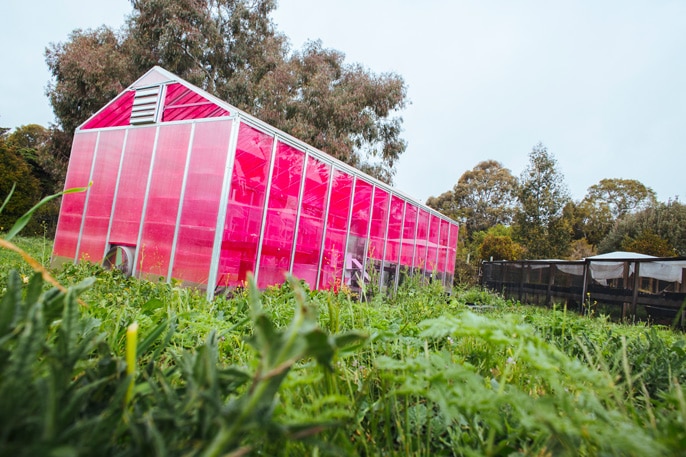Growing food and generating power in communities is often treated as an either-or option, especially if enclosures like greenhouses are used. Opaque PV modules create shade issues. Even with the use of transparent back sheets and a lower cell coverage ratio, a separate module and mounting system creates additional costs on a greenhouse, and may not admit the right spectrum of light that plants need to effectively grow. The same problem of useful light for plants exist with present building integrated PV systems.
A demonstration of solar powered greenhouses by the University of California, Santa Cruz (UCSC) addresses these challenges by using plastic-constructed greenhouses, including the photovoltaic cell containing panels, with only a small percentage of surface areas covered with PV cells and the rest treated with a translucent material that will transmit the photovoltaic spectrum to the cells, while allowing a pass thru of sufficient photosynthesis wavelength for effective plant growth.
The technology is called Wavelength-Selective Photovoltaic System (WSPV) by USCS, as described in their findings published in the American Geophysical Union’s journal Earth’s Future. The glazing system has a 12% silicon PV cell coverage with the remaining 88% treated with a luminescent solar concentrator (LSC) that has an 4% effective system factor. The theoretical efficiency is estimated to be 9.4%, and a 7% efficiency considered commercially feasible. Cost factors are significant in that a square meter bof WSPV can cost as low as $45/square meter, divided by $30 for PV cells, $10 for the LSC and $5 for the remaining materials. This would compare to $300/ m2 for smaller scale 90% cell coverage PV systems. Further cost reductions may be realized by using thin film PV instead of silicon. The visual result of WSPV is a striking magenta color.
The USCS study reported little or no difference in plant growth compared to a control greenhouse, and possible collateral benefits like reduced water usage. WSPV applications are scalable from backyard or community greenhouses up to multi-acre commercial farms. Commercialization of WSPV systems can lead to a multiplying factor in sustainably growing food and generating electricity.
This content is protected by copyright and may not be reused. If you want to cooperate with us and would like to reuse some of our content, please contact: editors@pv-magazine.com.








By submitting this form you agree to pv magazine using your data for the purposes of publishing your comment.
Your personal data will only be disclosed or otherwise transmitted to third parties for the purposes of spam filtering or if this is necessary for technical maintenance of the website. Any other transfer to third parties will not take place unless this is justified on the basis of applicable data protection regulations or if pv magazine is legally obliged to do so.
You may revoke this consent at any time with effect for the future, in which case your personal data will be deleted immediately. Otherwise, your data will be deleted if pv magazine has processed your request or the purpose of data storage is fulfilled.
Further information on data privacy can be found in our Data Protection Policy.